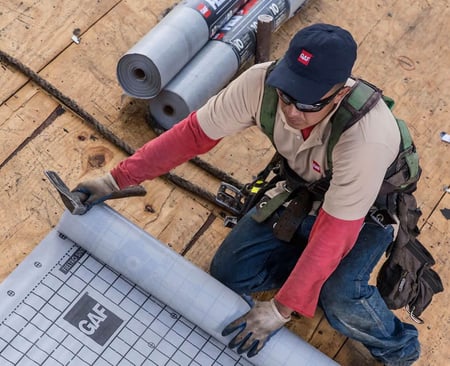Back to The Basics: What Is Roofing Underlayment?
December , 2023 | 6 min. read

Selecting the proper underlayment for your roof is a crucial decision that impacts the durability, protection, and resilience of your entire roofing system. Think of it as your roof’s protective layer, much like a jacket you’d wear when it’s cold or rainy. You wouldn’t want just any old coat that may not keep you warm and dry on those dreary days, right?
With various options available though, navigating through considerations such as weather resistance, cost-effectiveness, and compliance with local building codes can make choosing the right underlayment for your home tough. That’s where RoofCrafters comes in! We believe that understanding the importance of roofing underlayment and exploring the diverse choices available can empower homeowners like you to make informed decisions, ensuring long-term safeguarding against weather elements and structural integrity.
So, with that being said, knowledge is power, and if you’re currently exploring your underlayment options, you’re in the right place! In just a few short moments, you’ll learn exactly what underlayment is, why it is important to your roofing system, the options available to you, and your next steps. Let’s get started, shall we?
What Is Roofing Underlayment?

Roofing underlayment is a crucial component of a roofing system that's installed directly onto the roof deck before the shingles or other roofing materials are applied. Its primary purpose is to provide an additional layer of protection against water infiltration and other weather-related elements.
Roofing underlayment is essential because it acts as a secondary line of defense against leaks caused by wind-driven rain or any water that manages to get underneath the outer roofing material. It helps to protect the roof deck, prevents moisture buildup, and can provide temporary protection if the outer layer of the roof is damaged in a storm or during construction.
Why Is Roofing Underlayment Important?
Roofing underlayment plays a vital role in the overall protection and longevity of a roofing system. Here’s what makes it so important:
.png?width=1200&height=200&name=Recommended%20Reading%20(56).png)
Water resistance: Underlayment serves as a barrier against water infiltration. Even if the outer layer of the roof, like shingles or tiles, is damaged or doesn't provide a perfect seal, the underlayment acts as an additional defense against water entering the structure.
Protection from moisture: It helps prevent moisture buildup and condensation within the roofing structure, which could lead to rot, mold, and other forms of damage to the roof deck and the interior of the building.
Enhanced durability: Underlayment provides an extra layer of protection against physical damage during installation or severe weather conditions like heavy winds, hail, or debris impact. This helps extend the lifespan of the roof.
Temperature regulation: Some types of underlayment also offer insulation properties that can help regulate temperature and reduce energy costs by minimizing heat transfer through the roof.
Temporary protection: During roof installation or repairs, underlayment can provide temporary protection against the elements until the final roofing material is installed, preventing interior damage from rain or snow.
In essence, roofing underlayment acts as a safeguard, ensuring that the roof remains resilient against various weather conditions and external factors, ultimately preserving the integrity of the entire structure.
Does Every Roof Require Underlayment?

Not necessarily every roof requires underlayment, as it depends on several factors including the type of roofing material, local building codes, climate, and slope of the roof. Some roofing materials, like certain metal roofs or concrete tiles, might not require underlayment due to their inherent waterproof or moisture-resistant properties. However, even in these cases, underlayment might still be recommended for added protection against leaks and to meet building code requirements.
For most standard roofing installations using asphalt shingles or other common materials, underlayment is considered a fundamental component of the roofing system. It's typically recommended and often required by building codes to ensure adequate protection against water infiltration and to enhance the overall durability of the roof.
Factors such as the roof's pitch (slope), climate conditions (especially in areas prone to heavy rain or snow), and the specific requirements outlined in local building codes will often dictate whether underlayment is necessary. Consulting with a roofing professional or adhering to local building codes and manufacturer recommendations is the best way to determine whether your specific roof requires underlayment and what type would be most suitable for your situation.
What Are My Underlayment Options?
There are several types of underlayment available for roofing, each with its own characteristics and suitability for different roofing materials and conditions. Here are the main options:
.png?width=1200&height=200&name=Recommended%20Reading%20(57).png)
Asphalt-saturated felt: Commonly known as felt paper or tar paper, this traditional underlayment is made from a base of cellulose, polyester, or bitumen saturated with asphalt. It's cost-effective, offers basic water resistance, and comes in various weights (measured in pounds per square). Typical weights include 15, 30, and 40 pounds.
Synthetic underlayment: Made from polyethylene or polypropylene polymers, synthetic underlayment is more modern and offers enhanced durability, tear resistance, and better protection against moisture compared to traditional felt. It's lightweight, easier to handle, and usually comes in rolls. Synthetic underlayment is often more expensive than felt paper but provides better overall performance.
Rubberized asphalt underlayment: This type of underlayment combines asphalt with rubber polymers to create a highly flexible and self-sealing material. It offers excellent waterproofing and is ideal for areas prone to heavy rainfall or extreme weather conditions.
Peel-and-stick underlayment: Also known as self-adhesive or self-sealing underlayment, this type has an adhesive backing that sticks directly to the roof deck, creating a watertight seal around fasteners and penetrations. It's easy to install and provides superior protection against leaks.
Vapor barrier underlayment: Designed to prevent moisture from penetrating the roof deck, vapor barrier underlayment is particularly useful in areas with high humidity levels. It helps control condensation and moisture buildup within the roofing system.
Each type of underlayment has its own advantages and is suitable for different roofing materials and environmental conditions. Consider factors such as cost, durability, weather resistance, and local building codes when choosing the right underlayment for your roof.
Choosing the Right Roofing Underlayment

As you now know, roofing underlayment serves as a critical component in a roofing system, providing essential protection against water infiltration, moisture buildup, and physical damage. With various options available—such as asphalt-saturated felt, synthetic materials, rubberized asphalt, peel-and-stick, and vapor barrier underlayments—homeowners and contractors have a range of choices to suit different roofing materials, climates, and budget considerations.
The selection of the appropriate underlayment depends on factors like durability, weather resistance, cost, and local building code requirements. Understanding the specific needs of your roof and consulting with roofing professionals can guide you toward choosing the most suitable underlayment, ensuring enhanced longevity and resilience for your roofing structure.
Overall, regardless of the type chosen, roofing underlayment plays a vital role in safeguarding homes and buildings against weather-related damage, contributing significantly to the overall performance and integrity of the roof. If you’re due for a new roof and are curious about your underlayment choices, be sure to hit the “Schedule an Inspection” button down below, and one of our experts will walk you through your options!
My name is Cassie, and I’m the Content Manager here at RoofCrafters. I was born and raised in Chicago, Illinois, and made my way out to Florida post-college graduation. I’m incredibly passionate about writing and creating valuable content that helps others with the collaboration of my marketing team. When I’m not working, I enjoy shopping (a little too much), spending time at the beach, and reading!



